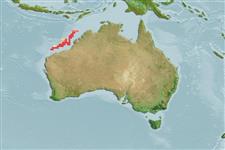>
Perciformes/Scorpaenoidei (Scorpionfishes) >
Neosebastidae (Gurnard scorpionfishes)
Etymology: Neosebastes: Greek, neos = new + Greek, sebastes = august, venerable (Ref. 45335); longirostris: Name after the Latin word 'longus' meaning long and 'rostrum' meaning snout, referring to the long snout.
Environment: milieu / climate zone / depth range / distribution range
Ecología
marino demersal; rango de profundidad 170 - 250 m (Ref. 54394). Tropical; 14°S - 20°S (Ref. 54394)
Eastern Indian Ocean: Off northwestern coast of Western Australia.
Tamaño / Peso / Age
Maturity: Lm ? range ? - ? cm
Max length : 16.9 cm SL macho / no sexado; (Ref. 54394)
Short description
Claves de identificación | Morfología | Morfometría
Espinas dorsales (total) : 8; Radios blandos dorsales (total) : 8; Espinas anales: 3; Radios blandos anales: 5. Diagnosis: Underside of mandible with numerous tiny pores, no ridges. Preocular spine usually simple, and flattened anteriorly and posteriorly; supraocular spines occurring only posterior to vertical midline of eye; no additional spines between lacrimal and suborbital ridges; upper opercular spine simple. Midinterorbital space covered with scales; interorbital space shallow, becoming shallower with growth. Pored lateral-line scales 34-36 (mode 35); longitudinal scale rows 57-63 (57). Pectoral-fin rays 20-22 (21); pectoral fin short (2.9-3.5, mean 3.2 in SL), not reaching a vertical at origin of last dorsal-fin spine. Posterior margin of maxilla not reaching a vertical at posterior margin of pupil. Snout length long (3.5-4.0, 3.7 in HL); interorbital width wide (5.2-6.7, 5.7 in HL); body depth shallow (2.8-3.4, 3.1 in SL). Bilobed portion of swimbladder less than half of total swimbladder length. There are no distinct small black spots on head or lateral line (Ref. 54394).
Found on the continental shelf and continental slope (Ref. 75154). Most specimens taken in trawls have sand grains inside the mouth indicating occurrence on open, predominantly sandy substrata (Ref. 54394).
Life cycle and mating behavior
Madurez | Reproducción | Puesta | Huevos | Fecundidad | Larva
Motomura, H., 2003. Revision of the scorpionfish genus Neosebastes (Scorpaeniformes: Neosebastidae), with descriptions of five new species. Indo-Pac. Fish. (37):46 p. (Ref. 54394)
IUCN Red List Status (Ref. 130435: Version 2024-1)
Threat to humans
Harmless
Human uses
Herramientas
Special reports
Download XML
Fuentes de Internet
Estimates based on models
Preferred temperature (Ref.
123201): 13.6 - 19, mean 16.5 °C (based on 11 cells).
Phylogenetic diversity index (Ref.
82804): PD
50 = 0.5002 [Uniqueness, from 0.5 = low to 2.0 = high].
Bayesian length-weight: a=0.01995 (0.00906 - 0.04395), b=3.01 (2.83 - 3.19), in cm total length, based on all LWR estimates for this body shape (Ref.
93245).
Nivel trófico (Ref.
69278): 3.6 ±0.4 se; based on size and trophs of closest relatives
Fishing Vulnerability (Ref.
59153): Low vulnerability (11 of 100).
